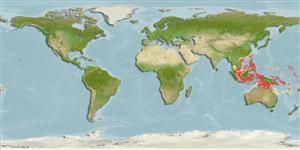>
Gobiiformes (Gobies) >
Gobiidae (Gobies) > Gobiinae
Etymology: Trimma: Greek, trimma, -atos = something crushed (Ref. 45335); xanthochrum: Name from the Greek ‘xanthos' meaning yellow or golden, and ‘chros’ for colour of the skin, or body surface, referring to the yellow colouration of the body and caudal fin..
More on author: Winterbottom.
Environment: milieu / climate zone / depth range / distribution range
Ecología
marino demersal; rango de profundidad 12 - 70 m (Ref. 87358). Tropical
Western Pacific Ocean: Indonesia.
Tamaño / Peso / Age
Maturity: Lm ? range ? - ? cm
Max length : 2.5 cm SL macho / no sexado; (Ref. 87358)
Short description
Morfología | Morfometría
Espinas dorsales (total): 7; Radios blandos dorsales (total): 7-8; Espinas anales 1; Radios blandos anales: 8. This species is characterized by the following: a wide interorbital region (80-100% pupil diameter); the second dorsal spine usually reaching posteriorly to between the bases of the second to third dorsal fin rays; pectoral rays 15-16, usually with 7-8 branched rays; vertical rows of sensory papillae below eye of 2-3 papillae in rows 1-4 and 4-5 in row 5; caudal blotch which has a lower half about two-thirds the width of the upper half; usually an overall yellowish body with yellow at least proximally in the caudal fin (Ref. 87358).
Inhabits current-prone reefs in 12-70 m (Ref. 90102).
Life cycle and mating behavior
Madurez | Reproducción | Puesta | Huevos | Fecundidad | Larva
Winterbottom, R., 2011. Six new species of the genus Trimma (Percomorpha; Gobiidae) from the Raja Ampat Islands, Indonesia, with notes on cephalic sensory papillae nomenclature. aqua, Int. J. Ichthyol. 17(3):127-162. (Ref. 87358)
IUCN Red List Status (Ref. 130435)
Threat to humans
Harmless
Human uses
Más información
Nombres comunesSinónimosMetabolismoDespredadoresEcotoxicologíaReproducciónMadurezPuestaAgregación para la puestaFecundidadHuevosEgg development
Age/SizeCrecimientoLength-weightLength-lengthLength-frequenciesMorfometríaMorfologíaLarvaDinámica larvariaReclutamientoAbundanciaBRUVS
ReferenciasAcuiculturaPerfil de acuiculturaRazasGenéticaElectrophoresesheritabilidadEnfermedadesProcesamientoNutrientsMass conversion
ColaboradoresImágenesStamps, Coins Misc.SonidosCiguateraVelocidadTipo de nataciónSuperficie branquialOtolitosCerebrosVisión
Herramientas
Special reports
Download XML
Fuentes de Internet
Estimates based on models
Preferred temperature (Ref.
123201): 26.7 - 28.9, mean 27.9 °C (based on 194 cells).
Phylogenetic diversity index (Ref.
82804): PD
50 = 0.5000 [Uniqueness, from 0.5 = low to 2.0 = high].
Bayesian length-weight: a=0.01023 (0.00477 - 0.02194), b=3.02 (2.84 - 3.20), in cm total length, based on LWR estimates for this (Sub)family-body shape (Ref.
93245).
Fishing Vulnerability (Ref.
59153): Low vulnerability (10 of 100).
